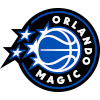As you move deeper into the draft, you'll find more and more pitchers with notable issues, including injuries, high walk rates, too many homers and more. When questions marks are a given one way to find value is to identify pitchers who at least have good stuff. That means looking for pitchers with one or multiple pitches that will generate whiffs, possess good velocity or show quality movement profiles. Sometimes, even with good stuff, the swings and misses don't follow, so we'll specifically be looking for movement profiles that should elicit more whiffs or induce weak contact. We shouldn't look past the question marks, as they make many of these pitchers high-risk and low-floor. I don't recommend rostering several of these pitchers on the same team, but all five are interesting young arms at various stages of development, ordered by personal preference based on my research.
Mitch Keller, P, PIT
I planned to include Cody Morris, but he's dealing with lat discomfort, so let's shift to an old friend in Mitch Keller. Early last season, Keller made some notable changes, and he maintained them throughout the year. While Keller posted a season-long ERA under 4.00, however, he took us on a roller coaster ride. Ratios aside, let's see if Keller's underlying metrics could provide optimism for the following season.
Unfortunately, Keller's K-BB rate isn't anything to write home about at 11.4 percent. Keller's four-seamer improved from a swinging-strike standpoint (from 6.7 percent to 10 percent), but his
As you move deeper into the draft, you'll find more and more pitchers with notable issues, including injuries, high walk rates, too many homers and more. When questions marks are a given one way to find value is to identify pitchers who at least have good stuff. That means looking for pitchers with one or multiple pitches that will generate whiffs, possess good velocity or show quality movement profiles. Sometimes, even with good stuff, the swings and misses don't follow, so we'll specifically be looking for movement profiles that should elicit more whiffs or induce weak contact. We shouldn't look past the question marks, as they make many of these pitchers high-risk and low-floor. I don't recommend rostering several of these pitchers on the same team, but all five are interesting young arms at various stages of development, ordered by personal preference based on my research.
Mitch Keller, P, PIT
I planned to include Cody Morris, but he's dealing with lat discomfort, so let's shift to an old friend in Mitch Keller. Early last season, Keller made some notable changes, and he maintained them throughout the year. While Keller posted a season-long ERA under 4.00, however, he took us on a roller coaster ride. Ratios aside, let's see if Keller's underlying metrics could provide optimism for the following season.
Unfortunately, Keller's K-BB rate isn't anything to write home about at 11.4 percent. Keller's four-seamer improved from a swinging-strike standpoint (from 6.7 percent to 10 percent), but his slider slightly declined from 15.2 percent to 12.7 percent in that category. That said, Keller's slider popped from a movement standpoint.
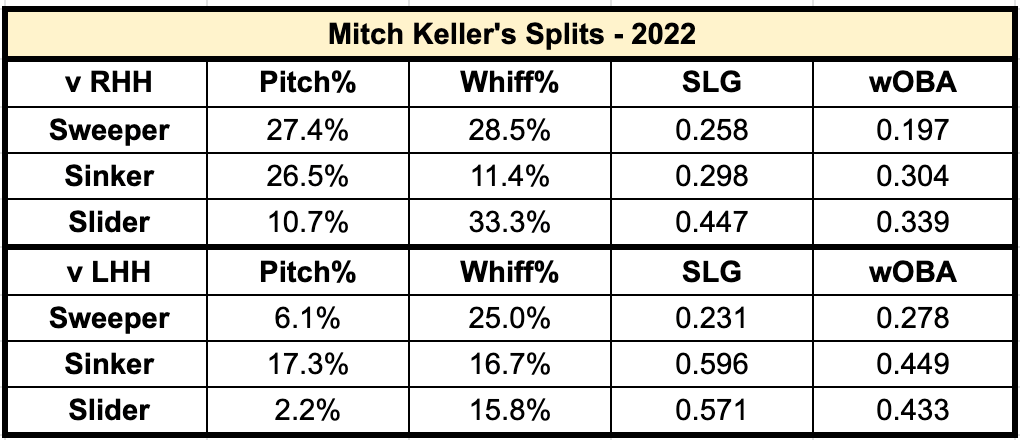
The table above demonstrates the effectiveness of Keller's sweeper and sinker against right-handed hitters. Baseball Savant adjusted its pitch classifications to be more accurate about Keller's arsenal, and you can see the difference in the results for his slider and sweeper above. Keller's slider has a higher velocity at 87 mph, with less drop and break than the sweeper, which sits at 83.2 mph and has an above-average movement profile in both vertical drop and horizontal break.
Against righties, the sweeper had a decent whiff rate and induced weak contact. The sinker served its purpose as well, generating groundballs and poor contact quality, as seen by the SLG and wOBA against the pitch. It's worth noting that Keller indicated he has a gyro cutter, which intends to be a cut fastball when it's up in the zone and more of a gyro slider when it's lower in the zone. From a velocity standpoint, his cutter is thrown harder (around 90 mph) with the slider hovering around 85 mph.
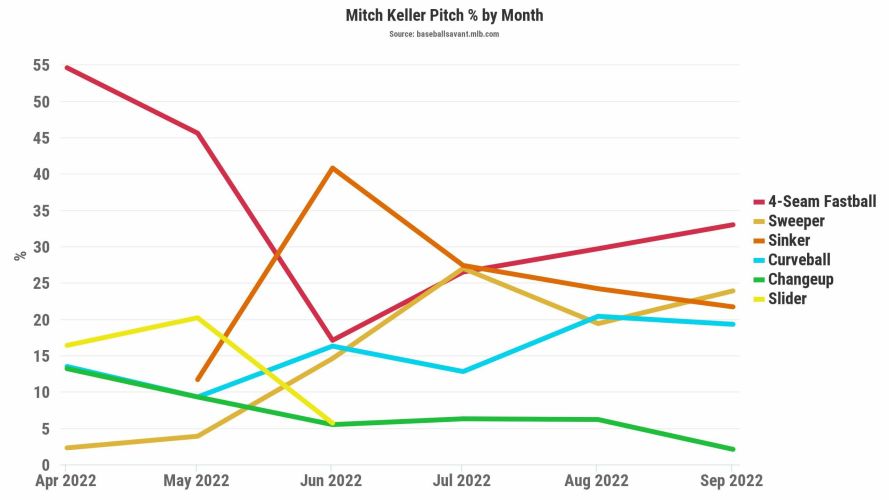
Keller lowered his four-seamer usage from 56.7 percent in April to 33.1 percent by the end of the year. The difference was made up by a sinker, a pitch he introduced in May. On the season, Keller threw his sinker 22.3 percent of the time, generating a 56.2 percent groundball rate. Not all pitch-mix changes automatically translate into positive changes, but it's notable given Keller's off-season work at Tread Athletics. Add in the gyro cutter and his repertoire starts to look quite exciting.
Keller finished the second half strong with a 2.93 ERA and 1.29 WHIP, thanks in part to an 80 percent strand rate. He went from a player who was had to roster in most leagues early on to a streamer in the second half. Keller will probably continue to hurt in WHIP going forward, but his ADP keeps rising, with offseason hype pushing him from pick 400 to around pick 350 over the past two months.
Keller is making positive strides as a pitcher with good stuff. While the sweeper, slider and gyro cutter can make for a confusing combination, the main positive takeaway is that Keller is looking at the data and making adjustments to be a better pitcher in 2023 and beyond. There's projection and speculation here, but I think the pitch-mix changes and offseason hype videos will at last translate into fantasy-viable skills and results for the 26-year-old righty.
Josiah Gray, P, WSN
There's no denying home runs remain an issue for Josiah Gray, whose career HR/9 through 21.91 innings sits at 2.34. A career 50.6 percent flyball rate has helped him to a low BABIP (.254), but remember that homers don't count as balls in play for that metric. Gray's curve and slider generate the most whiffs in his arsenal but also allow high home run rates. The curve had a 36.4 percent HR/FB rate in 2021, dropping to 18.5 percent last year. The slider likewise showed a decrease in HR/FB rate, so there's some hope that his overall home run rates improve with a newly added sinker. We'll touch on the sinker later, but first, let's examine Gray's two breaking pitches.
While all the loud contact is concerning, Gray does at least possess multiple pitches with quality swinging-strike rates. Unfortunately, both his slider and his curveball saw their swinging-strike rates fall, with the slider dropping to 18.4 percent and the curve slipping eight points to 12.7 percent. Gray threw the slider in the zone more frequently than he did as a rookie, and allowed more contact as a result.
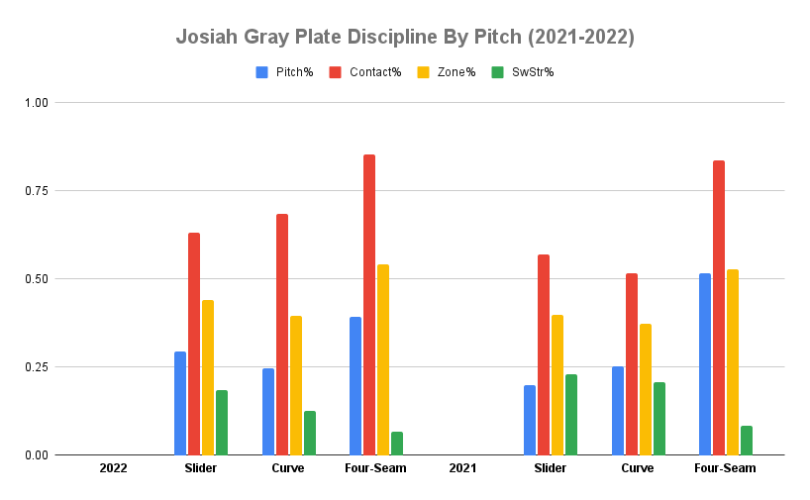
Hitters also made more contact on the curveball, as seen in the visual above. Given his five-point decline in overall first-pitch strike rate and his two-point increase in ball percentage, it's probably a command issue for Gray rather than a concerted effort to pitch to contact.
Shifting to pitch usage, Gray lowered his four-seam usage overall, with a 10-point drop versus righties and 14 point decline against lefties. He used his best pitch (his slider) more often against righties, a positive development.
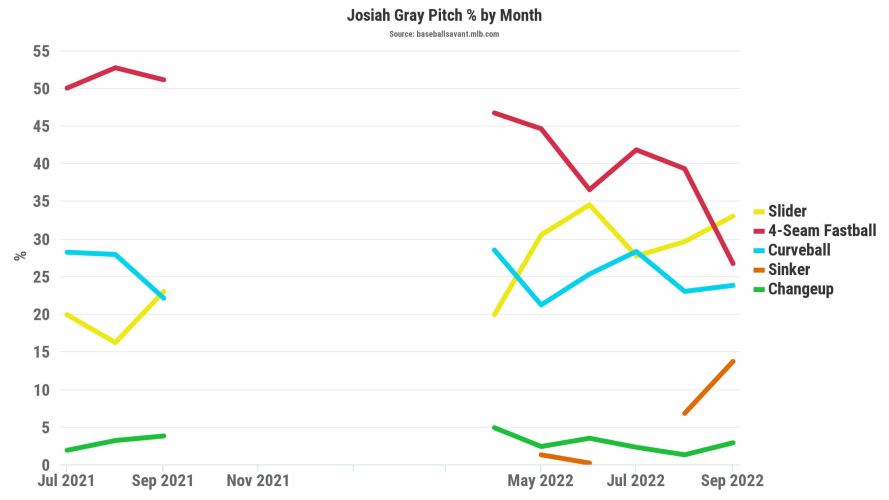
Gray also introduced a sinker in May, weirdly throwing it four times against right-handed hitters in one start before shelving it until August, when he brought it back and continued to use it primarily against righties. While the overall results (.524 SLG and .415 wOBA) looked poor, he only used it 3.7 percent of the time, so the sample size is small.
So, why is Gray's sinker interesting? Theoretically, it could generate groundballs, induce weak contact and profile differently from his other primary pitches. Its arm-side fade means it moves differently than the breaking pitches, which fall away from right-handers.
Gray's home run rates and brutal results seem baked into his ADP, which sits around pick 375. That's prime shopping for sleepers and bounce-back candidates. One could argue Gray has more concerns than reasons for optimism, but a deeper dive reveals some notable pitch-mix changes. Such changes don't automatically translate to results, and the very early results on the sinker have been poor, but it's positive to see the adjustments nonetheless. Gray's sinker could be the missing piece that lowers his home run rates and makes his breaking pitches stand out more. He remains a volatile sleeper starting pitcher.
Drey Jameson, P, ARI
The Diamondbacks have an enticing roster, particularly on the hitting end, but don't sleep on their potential back-end starters. That includes Jameson, who we'll discuss here, but also, Ryne Nelson, whose slider's swinging-strike rate comes in at 17.9 percent, and Brandon Pfaadt, who recorded a 26.9 percent K-BB rate across Double and Triple-A last year.
Jameson threw 24.1 innings in his major-league debut and had luck in his favor in the form of a 95.2 percent strand rate. Expect that mark to fall and his .281 BABIP to rise, since he generates groundballs at a high rate (56.1 percent). Jameson uses his slider and sinker to induce grounders, with the breaking pitch recording a 66.7 percent groundball rate and the sinker at 77.3 percent.
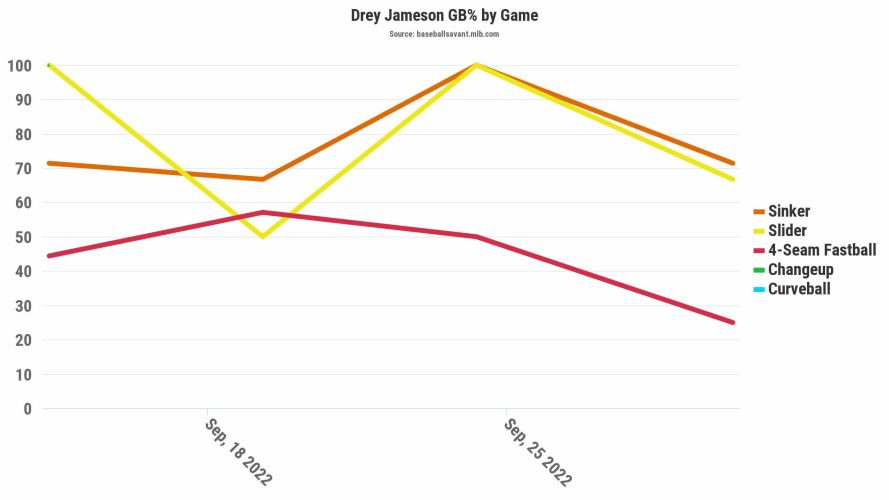
The slider is Jameson's most exciting offering, generating a 23.9 percent swinging-strike rate, the 28th-best mark among pitchers who threw at least 75 sliders. Add in the ridiculous chase rate of 47.6 percent (17th-best among that same group) and you get a nasty weapon with a movement profile that backs up the whiffs. Interestingly, Jameson used nearly an identical pitch mix versus righties and lefties apart from slight increase in changeups to (12.9 percent against lefties), though the sample is tiny.
While Jameson had some luck factors in his favor, he flashed intriguing skills. Theoretically, his groundball profile should help limit the home runs and provide a relatively steady floor. He could be a streamer as one of your final picks in a 15-team mixed league, though there could be more there.
Honorable Mentions: While Brandon Pfaadt isn't on the 40-man like Jameson and Ryne Nelson are, he ranks No. 41 on James Anderson's prospect list. Pfaadt's elite K-BB rate in the minors (26.9 percent) ranked fourth amongst all qualified MiLB pitchers in 2022. There's an argument to move Pfaadt ahead of Jameson on priority lists since he possesses quality command and durability (his 167 IP led all minor leaguers) plus an above-average slider. Consider Jameson, Pfaadt, and Nelson in that order in a 15-team mixed league as potential late-round selections with upside.
MacKenzie Gore, P, WSN
Shortly before last year's trade deadline, Gore suffered an elbow injury that led to an injured list stint. Then the Padres traded him in a package that included Luke Voit, CJ Abrams, Robert Hassell and James Wood for Juan Soto and Josh Bell. Gore rehabbed in the minors and attempted to return to the majors, but unfortunately, that never happened with the Nationals. After being one of the top pitching prospects in the game, Gore's stock fell, but some of his skills remain.
Gore flashed upside with three quality starts plus a handful of other solid outings early in the season. He also had three starts with a combined 24 earned runs in June and July, though we could blame those on misfortune more than anything, as the visual below indicates. Note how Gore's BABIP jumped along with his ERA while his FIP showed a much more modest increase.

Gore's breaking pitches elicit quality swinging-strike rates, with his curveball at 12.8 percent and his slider at 14.8 percent. He uses the slider more often against left-handed hitters, throwing it 28.1 percent of the time against them compared to just 11.6 percent of the time against righties. The results appear similar, but it's a small sample. Expect the metrics to shift with more innings.
Monitor the status of Gore's elbow, but he's worth the risk near pick 350. Don't overreact to his first spring training appearance, in which he threw an inning and topped out at 96.3 mph, but it's an encouraging sign which could cause his ADP to rise. It's worth mentioning that Gore made multiple brief rehab starts late last season and was on track to return for one start in the final week before the Nationals shut him down. That could mean the elbow issue is behind him.
Kyle Muller, P, OAK
When I tweeted about Kyle Muller last week, several people mentioned fading him since he's on the Athletics. While it's valid to be biased against pitchers on the team with the fourth-worst projected record per FanGraphs, Muller falls into the category of pitchers with good stuff we've been discussing throughout this article. Muller boasts two nasty breaking pitches, like Reid Detmers or Josiah Gray, with potentially fewer home run issues. He's gone from home-run luck being in his favor to regression in the opposite direction in his limited big-league sample so far, as seen in the visual below, with xFIP showing the potential for better results once his HR/FB normalizes.
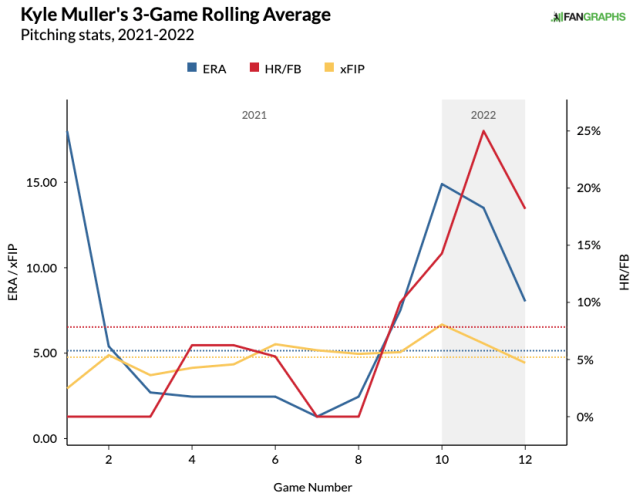
It's a small sample of 49 career innings in the majors, but Muller's slider elicited a 19.2 percent swinging-strike rate, while his curveball sits at 17.7 percent. Both breaking pitches have proved effective against right-handed hitters, with a .366 SLG and .320 wOBA against for the slider and a .136 SLG and .148 wOBA against the curve.
Muller has shut down lefties in his small sample. The southpaw relies on the slider 53.8 percent of the time against them, with the pitch generating a .167 SLG and .151 wOBA. His curveball is used less often and has less success against lefties, allowing a .571 SLG and .530 wOBA in his career. That said, the curveball has generated groundballs at a 66.7 percent clip for his career, and it should continue to help induce weak contact.
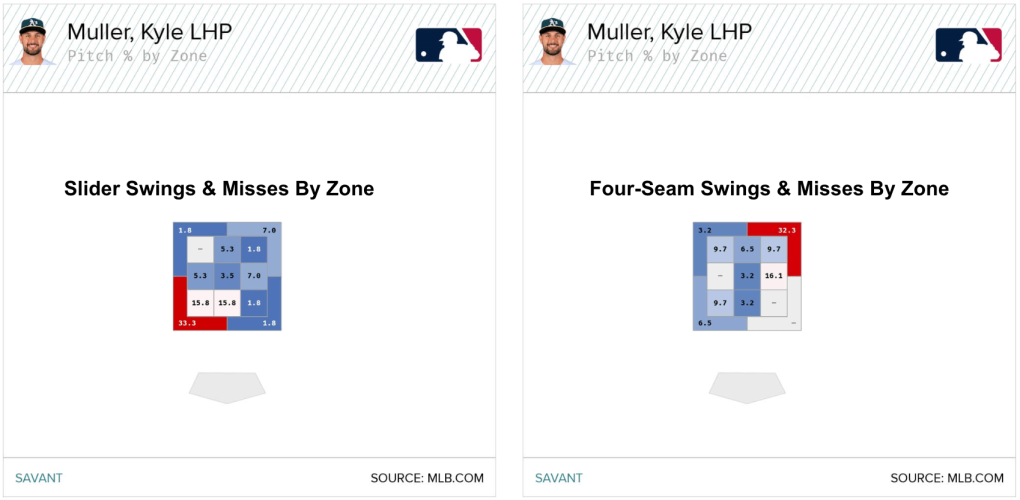
The visual above displays Muller's command and location tendencies for the slider and four-seamer, which are stark enough to raise concerns. His slider generates whiffs down and inside to right-handed hitters, while his four-seamer elicits swings and misses high and to his arm side. Opposing hitters could adjust and know what to expect based on Muller's pitch tendencies.
With all that in mind, the sample size is tiny (49 career innings), so take the data with a grain of salt. It makes sense for Muller to lower his four-seamer usage, since its movement profile doesn't generate whiffs or weak contact. Muller should attempt to locate the four-seamer high in the zone or maybe add a sinker, though that's easier said than done. That said, Muller is most relevant in draft-and-hold or AL-only formats, where his breaking pitches look juicy. Keep an eye on his early-season skills and pitch-mix adjustments.

















